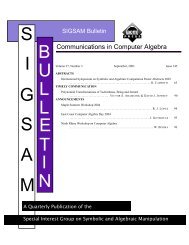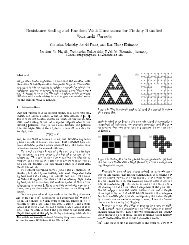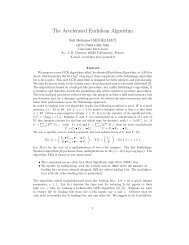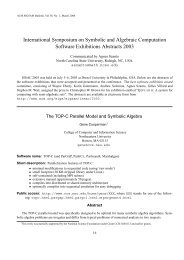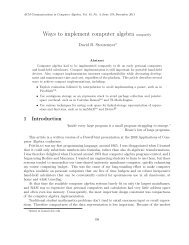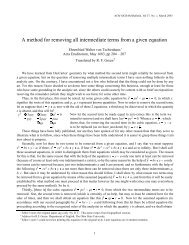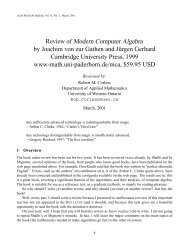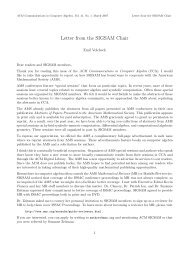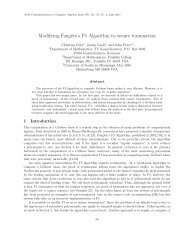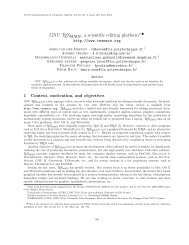Symbolic definite (and indefinite) integration: methods ... - SIGSAM
Symbolic definite (and indefinite) integration: methods ... - SIGSAM
Symbolic definite (and indefinite) integration: methods ... - SIGSAM
You also want an ePaper? Increase the reach of your titles
YUMPU automatically turns print PDFs into web optimized ePapers that Google loves.
<strong>Symbolic</strong> <strong>integration</strong>: <strong>methods</strong> <strong>and</strong> open issues<br />
The fact that these particular singularities are now detected means that recent Mathematica<br />
versions will correctly assess the divergence in the preceding example.<br />
5.5.3 Parametrized Singularities in Multiple Integrals<br />
Parametrized singularities can cause trouble, particularly in multidimensional <strong>integration</strong>. Here is<br />
an example from [12]. We begin with a small variation on the actual problem.<br />
∫ π<br />
∫ π<br />
0<br />
0<br />
2π<br />
Abs[Sin[x − y]]dydx<br />
Now we double the region of <strong>integration</strong> in both directions.<br />
∫ 2π<br />
∫ 2π<br />
0<br />
Abs[Sin[x − y]]dydx<br />
0<br />
4π<br />
The second one is off by a factor of 2. The problem is that one singularity line, x == y, is<br />
recognized. But the broken line x == y + π modulo 2π goes unrecognized. Hence we do not h<strong>and</strong>le<br />
ranges correctly, splitting only into two rather than three pieces in the first level of <strong>integration</strong>.<br />
Note that this is in version 5.0 of Mathematica; later versions do get the correct value of 8π.<br />
5.5.4 Branch Cuts Intersecting the Integration Path<br />
It is important to assess whether an <strong>integration</strong> path crosses a branch cut of an antiderivative (so<br />
that we might split the path into segments). The example below does this in order to get the correct<br />
result.<br />
∫ −2+i<br />
−1−i<br />
1<br />
4<br />
Log[x] dx<br />
( [<br />
(4 − 8i) − (1 − i)π + (4 + 8i)ArcTan<br />
1<br />
)<br />
2]<br />
+ (1 + i)Log[4] − (4 − 2i)Log[5]<br />
Version 4 of Mathematica failed to catch the crossing <strong>and</strong> gave a result with imaginary part off<br />
by 3π. Needless to say, this problem becomes vastly more difficult if the crossing might or might<br />
not exist based on parameter values. One might try the example below to get an indication of what<br />
might be a reasonable result.<br />
Integrate[Log[x], {x, −1 − I, y}]<br />
5.5.5 Problems with Algebraic Manipulation<br />
Here is an example that was quite wrong prior to version 5.1 (we show the result from version 5.0).<br />
ii = ∫ ∞<br />
2ye y BesselK [ 0, √ 3ySign[y] ] dy<br />
0 N[ii]<br />
NIntegrate [ 2ye y BesselK [ 0, √ 3ySign[y] ] , {y, 0, ∞} ]<br />
1 − ArcSec[√ 3]<br />
√<br />
2<br />
0.324489<br />
2.54593<br />
The problem was in the innards of the convolution code. At a key step we made use of an<br />
exponential of the form exp ( (−2i)π − log ( )<br />
4<br />
3)<br />
+ 2 log(2) <strong>and</strong> we subsequently required a square<br />
root. Once we replace exp with Mathematica’s Exp function we lose track of a factor of (−1) <strong>and</strong><br />
this gave rise to a bad result. While this example is now repaired, the general problem remains of<br />
how to find <strong>and</strong> forestall this phenomenon.<br />
12



